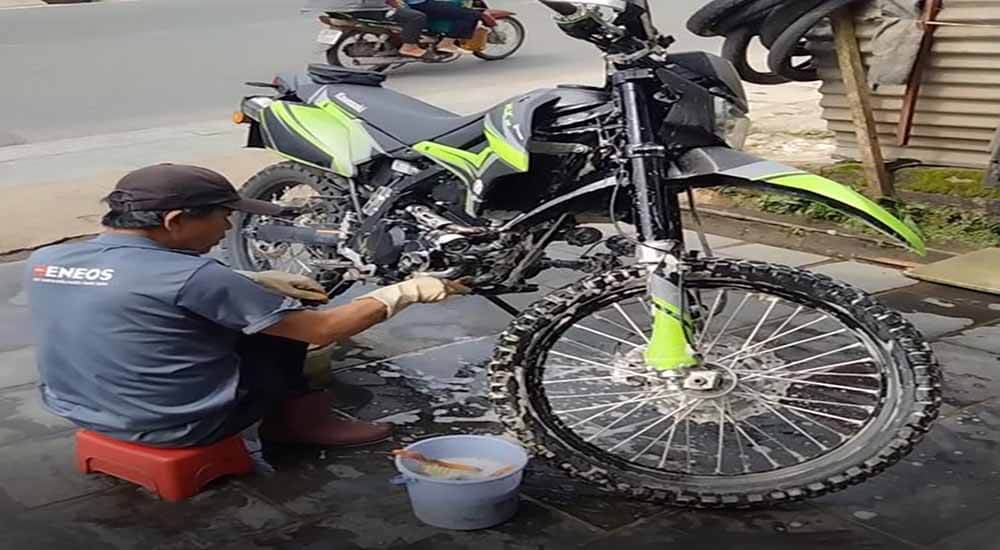Washing your motorcycle is one of the least exciting parts to owning and operating the two-wheeler, heck it can even be more cumbersome than power scrubbing a car! If you obsess over tidiness or have a shiny masterpiece, you might do it every other week. Generally, once every fortnight will do the trick. It’s not always about keeping her shiny but also a safety measure to remove debris and a chance to inspect any wear and tear. But motorcycles are also inherently delicate compared to cars with many electro-mechanical parts exposed, which begs the question — can you wash your motorcycle when it’s hot?
No! Don’t wash your motorcycle when it’s hot because water evaporates immediately it hits the hot surfaces and leaves behind ugly spots, which can be even more stubborn to remove. You also risk burning yourself on the hot bits. Engine failure is not relevant since it’s possible to cool rivers after a long day of riding with no damage. Otherwise, riding in the rain would damage it.
But do wait for about five minutes for the engine temperature to drop to a manageable zone. No, it’s not necessary to wait for the street-certified half hour. You want to get in there while things are still warm and stirring, so the grime rubs right off, and not hot enough to burn you.
Well, What About Hardening, You Might Ask?
Another concern the WWW seems to have with washing your bike while hot is metal hardening (physically altering the brittleness of the metal engine casing) due to rapid cooling. Okay Google, neither is the engine nearly as hot nor will dowsing water cool it fast enough to cause tempering. Hardening is an industrial process that happens in a highly controlled environment with temperatures in excess of 752°F (400 ºC) for aluminum blocks.
And yes, parts will wear out over time regardless of how hot you wash your bike.
How NOT to Wash Your Motorcycle

Here are some additional DON’TS to keep in mind when washing your motorcycle:
Don’t Use Car Cleaners or Domestic Detergents on Your Motorcycle
What’s good for the goose is good for the gander, right? Wrong! Motorcycles are delicate, and you should only clean them using special mild cleaning products specifically designed with their exposed bowels in mind. She might be mean and cold-hearted, but some detergents in your broom closet will rub her the wrong way.
To be sure it’s time to gear up and go shopping for the following specific brands of polish and shampoo for your motorcycle:
You can find these 9 best motorcycle cleaners on Amazon.
-
- Best General Motorcycle Cleaner Overall: S100 Total Cycle Cleaner
- Best Motorcycle Cleaner Runner-Up: Muc-Off Nano-Tech Motorcycle Cleaner
- Best Motorcycle Quick Detailer: S100 Detail & Wax Spray
- Best Waterless Motorcycle Wash: Muc-Off High-Performance No Rinse Bike Cleaning Spray
- Best Motorcycle Chain Cleaning Brush: Simple Solutions RGB800 Grunge Brush
- Best Motorcycle Wheel Cleaner: S100 Motorcycle Wheel Cleaner
- Best Motorcycle Chrome Cleaner and Polish: Simichrome 390050 All Metal Polish Tube
- Best Complete Motorcycle Cleaning Kit: S100 12000C Motorcycle Detailing Kit
- Best Motorcycle Chain Cleaner and Lube: Maxima 70-749203-3PK Chain Wax Ultimate Chain Care Aerosol Combo Kit

Motorcycle-specific cleaners contain dedicated surfactants and degreasers that are effective at removing dirt and grime without damaging the finish, protecting your two-wheel investment. And regardless of which cleaning solution you choose, it’s important to be gentle when cleaning. Avoid using harsh or abrasive cleaning agents, a dirty cloth or sponge, brushes, or sponges, and be sure to rinse the bike thoroughly to remove any soap or cleaner residue.
Don’t Wash Your Motorcycle Under the Scorching Sun
Ever suffered under the spell of those ugly streaks that show just when you began to bask in the glory of how well a job you did washing that hood? Well, it turns out the sun is the culprit in both cars and bikes. soap marks appear when the scorching sun vaporizes the soap.
It’s best to pick a nice cool spot under a shade or wash at dusk to avoid flailing the masterful finish.
My Top Recommended Oils & Chemicals — CLICK HERE! I highly recommend these motorcycle oils for their affordable yet top-notch quality, reflecting my extensive 50+ years of motorcycling experience and expertise as a rider, leader, and consultant in 25+ countries. So, whether you're a seasoned rider seeking an upgrade or a new enthusiast starting your journey on two wheels, I'm confident that these gear recommendations will serve you exceptionally well. |
Don’t Use Excessive Force to Remove Bug Stains

If loud pipes save lives, then bugs must not have the most acute hearing. Unfortunately, for them and for you, trying too hard to get them off your fairing and visor is the easiest route to a custom paint and body shop. A generous spritz of warm water will soften the grime, but if you don’t have the time, you can simply apply some WD40, the mechanic’s magic potion.
Yes, and there are actual products on the shelves labeled bug removers such as these five that you can find on Amazon.
The above will save you a lot of rinses as they are specifically designed to dissolve bugs and are kind on your surfaces. And regardless of which product you choose, it’s important to follow the manufacturer’s instructions carefully to ensure the best results and to avoid damaging the surface of your motorcycle.
Don’t Power Wash Your Motorcycle Chain
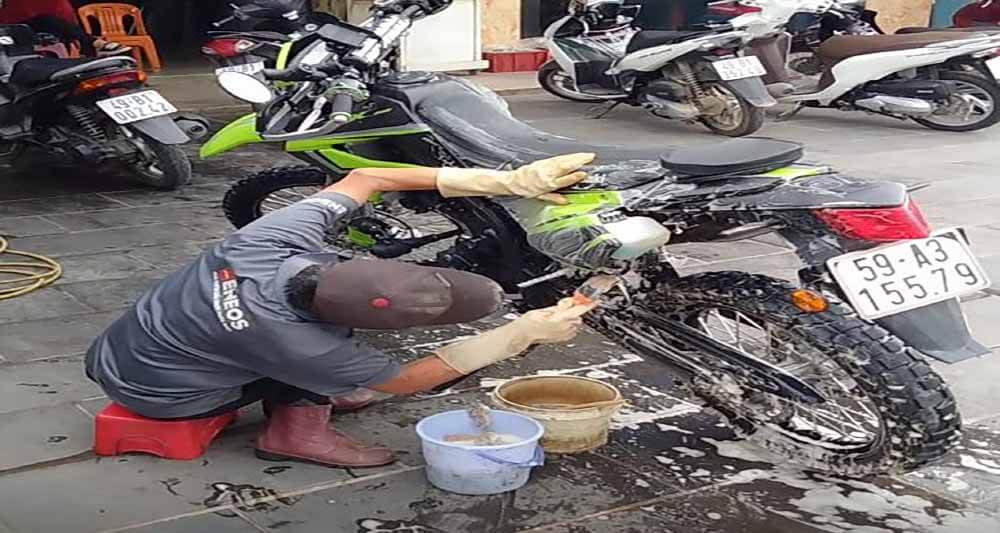
A power wash is an easy way to return those sport rims to factory spec, but it’s not as gentle on the intricacies of your two-wheeler. One part that is overrated for being tough is the motorcycle chain. It’s built for all manner of challenges, but it does not handle high-pressure jets well. The chain needs to stay lubricated and is designed to hold grease internally in the linkages.
Water jets can push dirt past the protective rubber rings, which is detrimental to the performance and longevity of the chain.
Don’t Forget to Oil the Chain After a Wash
In the same vein, you definitely need to remember to oil your chain after a wash. The O-rings, X-rings, and Z-rings may have your back for the factory-installed grease in the chain’s internal cavities. But unless you have an automatic chain oiler, you can rely on good judgment to do the necessarily.
Yeah, I know, it’s not part of washing your bike but, nonetheless, I thought it wise to mention it because I tend to forget myself. I digress! Here are some good motorcycle chain lubes I found:
Get these 6 reliable chain lubes for motorcycles on Amazon.
Again, these are just the ones I found most favored by verified reviews. Do your due diligence, and ask for recommendations from other motorcycle enthusiasts to find the best option for your needs. The right one will depend on your specific needs and preference.
More Don’ts When Washing Your Motorcycle
-
- Don’t use hot water to wash your motorcycle. Hot water can cause certain materials, like rubber, to become brittle and crack.
- You shouldn’t wash your motorcycle at a carwash because high-pressure water or a pressure washer can force water into electrical components or bearings and cause damage.
- Also, avoid power washing a motorcycle radiator (for liquid-cooled bikes) will damage the fins and reduce its efficiency.
- Avoid washing your motorcycle too frequently. Overwashing can strip away the protective wax on the surface and make it more susceptible to damage. Aim to wash your motorcycle every two to four weeks, depending on how often you ride and the conditions you ride in.
- Never wax your bike in direct sunlight as it will brittle and crack.
Enough DON’TS, now here is the proper way to wash a motorcycle.
Best Practices When Washing Your Motorcycle
Maintaining a clean motorcycle not only enhances its appearance but also helps to extend the life of its components. Proper washing techniques are crucial to preserving the integrity of your motorcycle and avoiding costly repairs. Here are some best practices to follow when washing your motorcycle:
Use a Separate Bucket for Rinsing
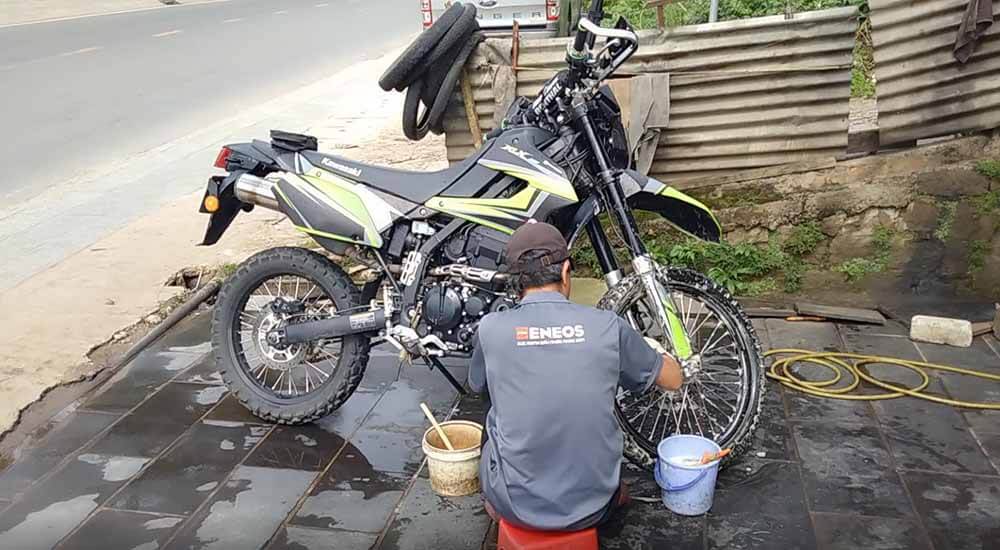
A useful trick I have learned is to have two huge buckets at hand when washing your motorcycle. If water is no object, and you have proper drainage, you can use a garden horse because dirt and grime tend to accumulate on the cloth and harm your paint job.
Now, on one hand, have a bucket with the cleaning solution and one with just pure water on the other. Every time you want to apply more detergent, rinse the cloth in clean water to remove the debris before scooping the soapy water. You will not only save on water and soap but also avoid rubbing abrasive dirt back on the bike.
Use a Fine Cloth for a Gentler Scrub
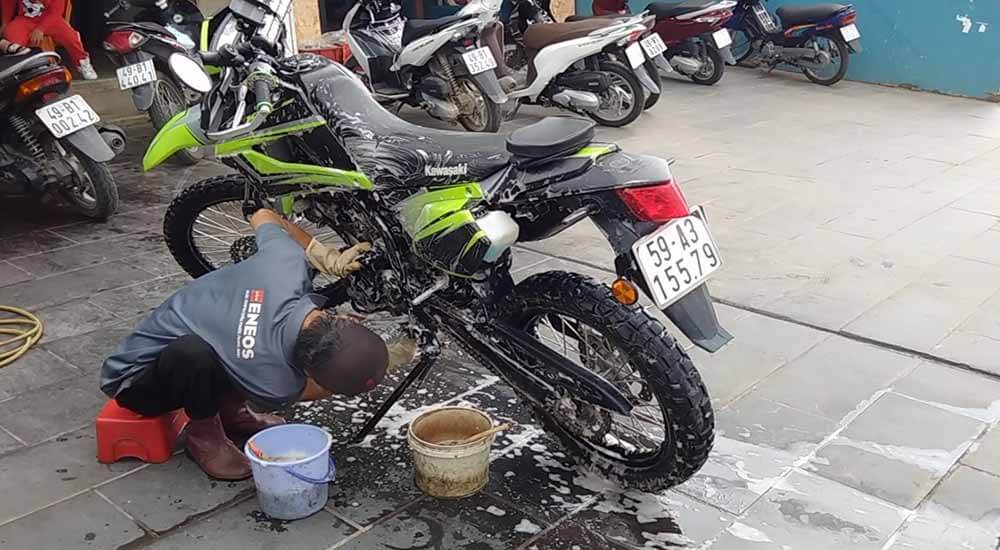
Your old T-shirt will not cut it, use a fine microfiber cloth to be as gentle and as thorough as possible. This special cloth is less likely to scratch your paint and has the added advantage of excellent water absorption for quick and easy rinsing and drying.
Block Exhaust to Prevent Water Entry
River crossings are a challenge for motorcycles if they submerge the exhaust pipe. Similarly, while washing and rinsing your motorcycle, you want to avoid getting water in there as it is likely to pool inside and cause trouble down the road. A word of caution, motorcycle exhausts can get extremely hot and can cause serious burns if you touch them too soon after a long ride.
My 8-Point Method to Properly Wash a Motorcycle
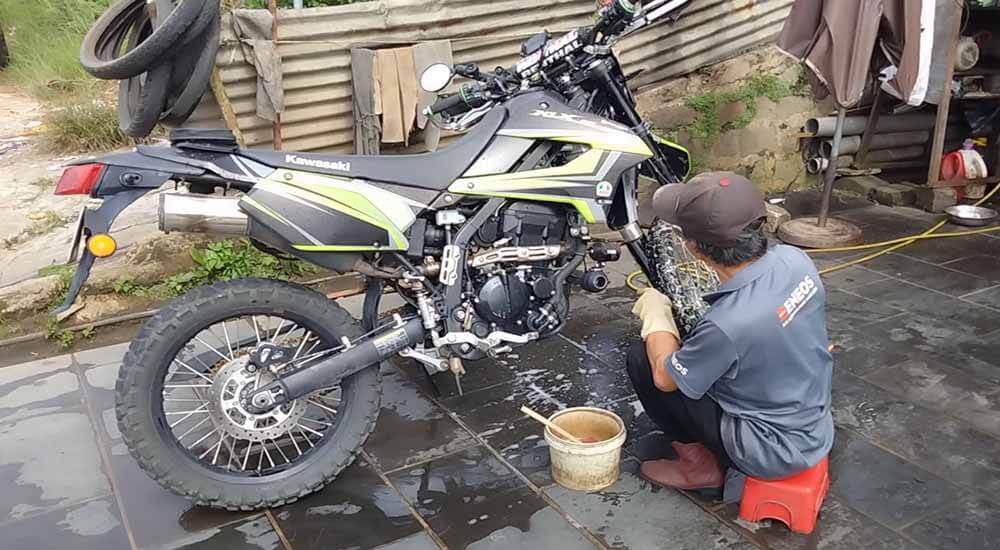
Washing a motorcycle can help to keep it looking clean and well-maintained. Here is a step-by-step guide to washing a motorcycle:
-
- Gather your supplies. You will need a bucket of soapy water, a hose with a high-pressure nozzle or a second bucket of clean water, a sponge or washcloth, a microfiber towel, some protective washing gloves, and a silicone-based tire shine product.
- Start by rinsing off any loose dirt and debris from the motorcycle with the hose. Be sure to aim the nozzle at any crevices or hard-to-reach areas to remove as much dirt as possible.
- Using the bucket of soapy water and the sponge or washcloth, wash the body of the motorcycle, starting at the top and working your way down. Be sure to pay special attention to the wheels and any other areas that tend to accumulate dirt and grime.
- Rinse off the motorcycle with the hose to remove all of the soap and dirt.
- Dry the motorcycle off with the microfiber towel. Be sure to dry off any crevices or hard-to-reach areas to prevent water spots from forming.
- Lubricate the chain.
- Apply the tire shine product to the tires to give them a nice, glossy finish.
- If desired, you can also apply a wax or sealant to the body of the motorcycle to help protect the paint and keep it looking shiny.
That’s it! With these steps, you can help keep your motorcycle looking clean and well-maintained.
The Takeaway on Can You Wash Your Motorcycle When It’s Hot
So, you hit some twists and got a little carried away, or were you out chasing the sunset and those scanty mountain goat trails again? Whichever the case, what matters is that you are home and dry now, but there is one little thing you have to take care of first, your throbbing iron heart is stained with bugs, grease, and mud. It’s quite the chore, but if you keep calm and follow our guide, you will have her nice and clean in no time.
Start by allowing the bike to cool down sufficiently as you gather the necessary supplies. Be sure to get the right kind of cleaners and buffing solutions designed for use with bikes. As you wash, avoid using a pressure washer if you can, and be gentle on the chain and other mechanical and electrical bits and bobs that are exposed. Take the opportunity to inspect oil leaks, cracks, and stripped paint to do necessary repairs and maintenance.
Don’t do it too frequently, but when you do, wash your bike the proper way.
Information for this article was partially sourced and researched from the following authoritative Government, educational, corporate, and nonprofit organizations:
MS/A
 I've diligently categorized my motorcycle gear recommendations into all available categories, with the aim of providing you with a comprehensive analysis that showcases the absolute best options for all your needs. These items are the culmination of in-depth research, extensive testing, and personal use throughout my vast experience of 50+ years in the world of motorcycling. Besides being a passionate rider, I've held leadership positions and offered consultancy services to reputable companies in over 25 countries worldwide. To See Our Top Picks and the Best Prices & Places to Buy: Click Here! |

